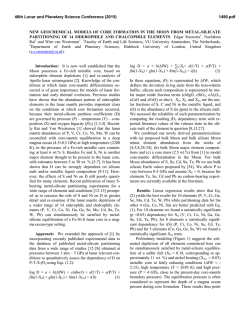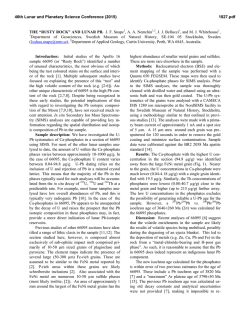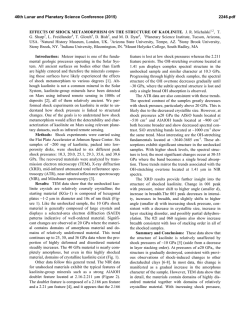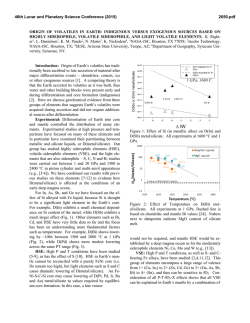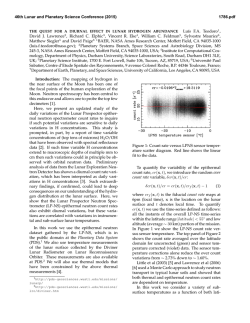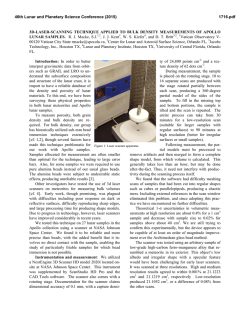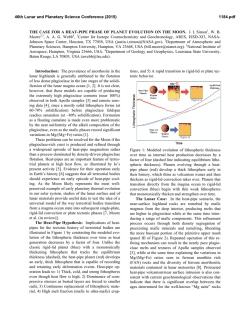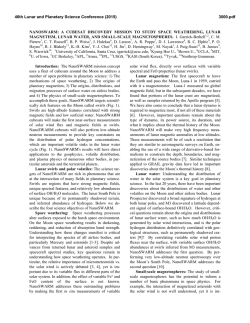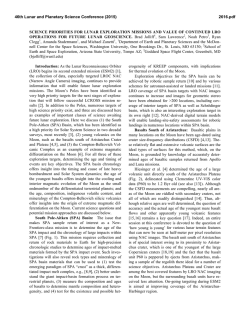
EXPERIMENTS ON LUNAR CORE COMPOSITION - USRA
46th Lunar and Planetary Science Conference (2015) 2285.pdf EXPERIMENTS ON LUNAR CORE COMPOSITION: PHASE EQUILIBRIUM ANALYSIS OF A MULTI-ELEMENT (Fe-Ni-S-C) SYSTEM. B.M. Go1, K. Righter2, L. Danielson3, K. Pando3, 1University of Chicago, Department of Geophysical Sciences, 5801 S. Ellis Ave., Chicago, IL 60637 ([email protected]); 2Mailcode KT, NASA Johnson Space Center, 2101 NASA Pkwy, Houston, TX 77058; 3Jacobs JETS, NASA Johnson Space Center, 2101 NASA Pkwy, Houston, TX 77058. Introduction: Previous geochemical and geophysical experiments have proposed the presence of a small, metallic lunar core, but its composition is still being investigated [1-3]. Knowledge of core composition can have a significant effect on understanding the thermal history of the Moon, the conditions surrounding the liquid-solid or liquid-liquid field, and siderophile element partitioning between mantle and core. However, experiments on complex bulk core compositions are very limited. One limitation comes from numerous studies that have only considered two or three element systems such as Fe-S or Fe-C [4-6], which do not supply a comprehensive understanding for complex systems such as Fe-Ni-S-Si-C. Recent geophysical data suggests the presence of up to 6% lighter elements [12]. Reassessments of Apollo seismological analyses and samples have also shown the need to acquire more data for a broader range of pressures, temperatures, and compositions [20]. This study considers a complex multi-element system (Fe-Ni-S-C) for a relevant pressure and temperature range to the Moon’s core conditions. Experimental and Analytical Approach: The bulk composition was calculated using S and C geochemical analyses of trapped melts in Apollo samples [7-9]. Knowledge of the concentration of S and C in these melts gives the mantle concentration of these elements [7-9]. Metal/silicate partition coefficients (D = wt% in metal / wt% in silicate) for these elements, DS and DC, are calculated using oxygen fugacity, lunar core temperature and pressure, degree of melt polymerization, and mole fractions of S and C [10-11]. Combining the mantle concentration with D(metal/silicate) results allowed for calculation of core S and C contents. The bulk composition was prepared by mechanical mixing of 90% Fe, 9% Ni, 0.5% C, and 0.375%S by weight from Fe, Ni, C, and FeS reagent grade powders. Experiments were carried out under conditions of temperatures ranging from 1473K to 1973K and pressures from 1 GPa to 5 GPa. The composition was placed in MgO capsules so that minimal reaction between capsule and metal could occur. For experiments at 1 and 3 GPa, samples were placed in a piston cylinder apparatus using graphite furnaces and 10 mm or 13 mm BaCO3 cell assemblies under a constant pressure of 1 GPa or 3 GPa. For experiments at 5 GPa, samples were placed in a 14/8 assembly and performed on the 800-ton multianvil press. Samples were carbon-coated and then analyzed for Fe, Ni, and S composition using a Cameca SX100 electron microprobe. Beam conditions consisted of a 30-µm or 50-µm diameter beam with a 15 kV accelerating voltage and a 20 nA sample current. The microprobe was standardized to metallic standards (troilite, Ni-metal, and Ni515). All runs at 1 and 3 GPa gave consistent concentration values with average totals of 99-100%, and backscattered electron images were acquired of different quenched phases. Carbon abundance was not yet measured in these experiments. Run T(K) P(GPa) Phases S% Go 1.12 Go 1.13 Go 1.14 Go 1.15 Go 1.16 Go 3.13 Go π Go 3.15 Go 3.16 Go 3.17 1473 1573 1673 1773 1873 1573 1673 1773 1873 1973 1 1 1 1 1 3 3 3 3 3 2 sol 1 sol + 1 liq 1 sol + 1 liq 1 sol + 1 liq 2 liq 1 sol + 1 liq 1 sol + 1 liq 1 sol + 1 liq 1 liq 1 liq 0.02, 0.02 0.04, 31.2 0.04, 9.0 0.03, 2.9 0 .2 , 0 .4 0.06, 14.1 0.02, 2.6 0.02, 0.4 0 .4 0 .3 Table 1 Piston cylinder experiments shown, including phases found under an optical microscope and S wt%. Results: For this composition, the liquidus was found to occur between 1773K and 1873K. At 1 GPa, the liquid coexisting with the solid FeNi metal has 2.9 wt% S at 1773 K, and as temperature decreases the liquid become more S-rich with 31.2 wt% at 1573 K (Table 1). Figure 1 shows a backscattered electron image of the solid and liquid phases at 1 GPa. At 3 GPa, the liquid contains 0.4 wt% S at 1773 K and decreases to 14.1 wt% at 1573 K. The two liquid phase only found in one sample is probably not likely because it is inconsistent with [6] and is possibly a result of being along the cool end of a thermal gradient. The 46th Lunar and Planetary Science Conference (2015) two-solid field in Go 1.12 is probably due to lack of homogeneous mixing in this subsolidus sample. 30 µm MgO Capsule Liquid Phase Solid Phase 2285.pdf of thermal models available [18-19], we considered [17]. When combined with our results, a solid inner core (and therefore initiation of a dynamo) may have been possible in the earliest history of the Moon (~4.2 Ga ago), in agreement with [16]. Future Work: Carbon measurements still need to be completed on these samples in order to further understand the phase equilibria of this composition. Multi-anvil experiments at 5 GPa are required to have a more complete data set. More studies on geochemically plausible core compositions with varying S, C, and Si are necessary to further constrain the core composition and evaluate the geophysical and geochemical data. Figure 1 Sample Go 1.14 (1673K and 1 GPa) backscattered electron (BSE) image. Shown is MgO capsule (black), Ferich solid phase (gray), and S-rich liquid phase (gray with black dendrites). Discussion: Depending on the thermal model used, the pressure (4.5 GPa – 5 GPa) and temperature (1600K – 1875K) conditions close to the lunar core can vary, which would result in different core structure and phases. One lunar core structure includes the presence of one liquid phase, at temperatures above the liquidus. A second possible structure includes the presence of a liquid phase and a solid phase, just below the liquidus. This is consistent with recent seismic data and geochemical modeling that suggest the presence of a solid inner and fluid outer core, containing less than 6% of lighter elements and being sulfur rich [12], and the growing evidence for a partially liquid core, such as from recent magnetic measurements [15, 16]. There have been many studies on a lunar core dynamo that may have caused a magnetic field at least 3.6 Ga ago through the previous presence of a growing inner core or convecting liquid core [1719]. [20] found a core dynamo consistent with paleomagnetic data with a very high S wt% of about 6-8%. This would require at least 500 ppm of S in the mantle, which is not the case as shown by trapped melts in Apollo samples and partition coefficient data on S concentrations [8, 11]. Using a temperature vs. time graph [17] for our composition, we can find the lunar core dynamo’s starting point by analyzing the Moon’s cooling history (Fig. 2). While there are a number Figure 2 Displayed is a core-mantle boundary (modeled as similar to the core temperature) Temperature vs Time graph of the lunar core based on [17]. The arrow shows the point where the lunar core dynamo may have started once the core of this composition began to solidify at ~4.2 Ga. References: [1] Righter, K. (2002) Icarus 158, 113. [2] Runcorn, S.K. (1995) GCA 60, No. 7, 12051208. [3] Newsom, H.E. (1984) Eos Trans. AGU, 65, 22, 369-370. [4] Li, J. et al., (2001) EPSL 193, 3-4, 509-514. [5] Buono, A. et al., (2011) GCA 75, 2072-2087. [6] Dasgupta, R. et al., (2009) GCA 73 6678-6691. [7] Wetzel. D.T. et al., (2013) PNAS 110, 20, 8010-8013. [8] Bombardieri, D.J. et al., (2005) Meteoritics, 40, 5, 679-693. [9] Wetzel, D.T. et al., (2014) LPSC XLV, 2238. [10] Chi, H. et al., (2014) GCA 139, 447-471. [11] Boujibar, A. et al., (2014) EPSL 391, 42-54. [12] Weber, R.C. et al., (2011) Science 331, 309-312. [13] Fei, Y. et al., (2000) Am. Mineral, 85, 1830-1833. [14] Deng, L. et al., (2013) GCA 114, 220-233. [15] Williams, J. et al., (2001) JGR 106, 27933-27968. [16] GarrickBethell, I. et al., (2009) Science 323, 356-359. [17] Konrad, W. et al., (1997) Adv. Sp. Res. 19, 10, 15111521. [18] Spohn, T. et al., (2001) Icarus 149, 5465. [19] Hess, P.C. et al., (1995) EPSL 134, 501514. [20] Righter, K. et al., (2014) LPSC XLV, 2111.
© Copyright 2026
